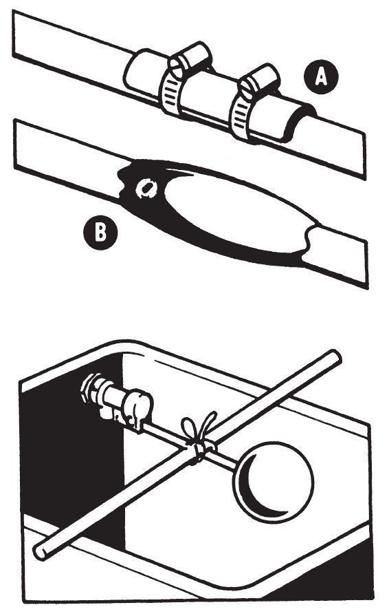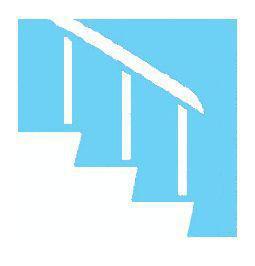SAS Urban Survival Handbook (18 page)
Read SAS Urban Survival Handbook Online
Authors: John Wiseman
Tags: #Health & Fitness, #Reference, #Survival, #Fiction, #Safety, #Self-Help, #Personal & Practical Guides, #General, #Survival Skills

Sometimes it is necessary to disconnect the waste pipe from the appliance and push something down the pipe to clear the blockage. A length of hosepipe may work, particularly if connected to a running tap—but BEWARE of the backwash, particularly if you have tried using a chemical drain clearer. If nothing works, call in an expert.
Tank/cisterns overflowing:
A stream of water is issuing from an external overflow/warning pipe. The ballcock is allowing the tank to overfill. It may have jammed. It may be adjusted too high. It may have filled with water so that it is not floating. Most likely the washer or diaphragm on the inlet valve needs replacing—to make it cut off the water supply when the water level is correct.

WARNING
Overflowing water in winter may create a slippery ice patch on the ground below. Accidents do happen! The water may also freeze as it leaves the pipe. This freezing may travel back to the cistern. Fix the simple problem—and save having to deal with even worse ones.
Freezing pipes/tanks/cisterns:
The whole water system should be lagged to prevent freezing. Don’t carry loft insulation under cisterns—they need all the warmth they can get. If a pipe freezes, the expansion of the ice may split the pipe or force a joint apart. When it thaws you will get very wet! If freezing occurs, turn off hot water and central heating systems—the water is not flowing and this equipment may overheat.
Thawing should be done with great care, and only on identified areas of freezing. If the whole system is frozen you may need to call in a specialist. Don’t use blow torches or hot-air strippers. You may melt plastic pipes—or the solder at (capillary) joints. A hairdryer is fine, used with care—but be careful of spurting water if dealing with a split pipe (turn off the stopcock!). An electric fire, used with great care, may be all right to gently warm a cistern—but supervise constantly.
Leaky joints:
There are two main types of plumbing joint—soldered (capillary) joints and larger compression fittings which have to be tightened with spanners or wrenches. Problems at soldered joints mean that the whole system has to be drained of water. Compression fittings may be gently tightened (if they are recent fittings)—but beware of over tightening. Consult a specialist.
Leaky taps:
When taps leak from the spout, the washer needs replacing. If they leak from the top, the packing or O-ring seal is faulty. Don’t keep tightening a leaky tap, you may wear down the seating for the washer and then the whole tap may need to be replaced.
Central heating overheating:
Can be very serious, may be for any of a number of reasons:
- ◑ The chimney or balanced flue (room-sealed flue) may be blocked. Clear all obstructions.
- ◑ The system could have become loaded with limescale. It will need draining down and treating by a specialist.
- ◑ The thermostat on the boiler may be faulty. Shut the system down and call a specialist.
- ◑ The main thermostat or programmer may be faulty. Shut the system down and call a specialist.
- ◑ The pump may not be working (you can hear it running, or feel a slight vibration if you touch it). Shut the system down. The pump must be isolated and serviced.
- ◑ A motorized valve may be stuck. Most systems include at least one electrically-operated valve which controls water flow. This is quite a common problem. Shut the system down and have the valve replaced. In most cases, only the tiny motor needs replacing—which means you won’t have to drain the system.
Radiator problems:
If a radiator stays cool at the top, there is air in the system. You could be damaging the system. Buy a key and gently ‘bleed’ the radiators. Slowly and carefully undo the valve, holding a cloth ready to stem the flow of water. Air hisses as it escapes, bubbles follow—when water flows, quickly close the valve. Bleed all radiators at the beginning, middle and end of the heating season as part of simple routine maintenance.
If a radiator is cool in the middle and cold at the bottom, you have a build up of sludge, corrosion particles and debris which need flushing from the system. Consult a specialist, before the system is damaged.
If either of the above is allowed to continue for too long, radiators may be damaged beyond repair. In the worst cases, a radiator may pinhole—spurting water under pressure!

EMERGENCY! BURST PIPE/TANK FLOOD
- ▶
Locate main stopcock and turn it off - ▶
If water has reached an electrical appliance or light fitting: DON’T touch the appliance Go to the fuse box/consumer unit and cut the power - ▶
Turn on all the taps, to drain the pipes and tank - ▶
Turn off your central heating/immersion hot water heater
BURST PIPE
If you can locate the actual source of the leak, a do-it-yourself repair may be possible. Repair ‘kits’ include hose clips (A) or epoxy putty (B). Otherwise call a specialist.
BURST TANK
If the tank is leaking, turn off the supply to the tank—or tie up the ballcock to prevent the tank refilling. You may now be able to turn the main stopcock back on again to get drinking water.

YOU COULD TRY
If the patch of damp is on a ceiling and is dripping, it could be worth making a small hole in the centre with a small screwdriver. Stand on a stepladder, NOT a chair. Don’t forget to have a couple of buckets ready to catch the water.
If the leak is very bad
and the ceiling is drooping—and dripping in the centre—be VERY careful. Piercing the bulge may be possible. It would be safer to evacuate the room if the ceiling looks likely to fall.
COMMON ACCIDENTS
 Casualties from accidents in the home are more numerous than those on the roads. Everyone is at risk, particularly children under four—with peak risk at two—and the elderly. The kitchen is the most dangerous room, it seems, with up to 25 per cent of accidents related to it. First-aid advice given here is abbreviated as a reminder for emergencies only.
Casualties from accidents in the home are more numerous than those on the roads. Everyone is at risk, particularly children under four—with peak risk at two—and the elderly. The kitchen is the most dangerous room, it seems, with up to 25 per cent of accidents related to it. First-aid advice given here is abbreviated as a reminder for emergencies only.
PLEASE NOTE
All EMERGENCY! and SAVE A LIFE! panels are intended only to guide you through emergency procedures, and to avoid the need to search through the pages of this book in a crisis. More detailed instructions appear in the HEALTH chapter. Learn the procedures BEFORE you need to use them.
FALLS
 The most common of all accidents. Usually caused by loose or worn carpeting, slipping or tripping on toys or other objects left on the floor and stumbling over appliance flexes. The majority of accidents involve vacuum cleaners—caused by tripping over or stepping backwards on to them! Bad lighting is often a contributory factor.
The most common of all accidents. Usually caused by loose or worn carpeting, slipping or tripping on toys or other objects left on the floor and stumbling over appliance flexes. The majority of accidents involve vacuum cleaners—caused by tripping over or stepping backwards on to them! Bad lighting is often a contributory factor.
Children under two try to walk or crawl up- or downstairs before they are physically ready to do so. Even as they get older, children are easily thrown off balance if they catch a toe on a piece of carpet or slip on a shiny floor. Rushing round a corner, they may fail to judge their speed sufficiently well to stop.
Falls from windows account for many deaths and injuries, especially for children. Low windows, especially those with climbable objects in front of them, are the most dangerous. Balcony rails which can be squeezed through or climbed are another serious risk.

SAVE A LIFE!
FALLS
There may be no cuts and bruises, but internal injuries are possible. Concussion is likely after a blow to the head. Even worse, compression may develop—which is life-threatening. ALWAYS seek medical attention.
Worn and loose floor coverings can be a real hazard. Non-slip mesh is available in two versions to stabilize rugs on polished floors or to prevent them creeping on carpets.
- ◑ Repair any rents, which could catch either toe or heel, or replace.
- ◑ Ensure rugs don’t curl up at the edges.
- ◑ Don’t polish the floor beneath rugs.
- ◑ Keep stair coverings close fitting.
- ◑ Avoid loose mats at top or bottom of stairs.